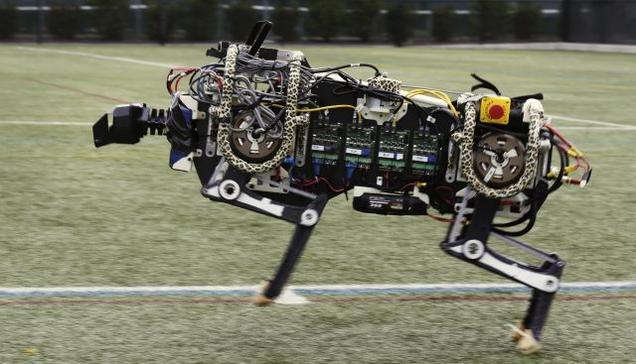Fast, faster, fastest: This cheetah robot can run at 16 kph
02:00AM Wed 31 Dec, 2014

It’s a robot unlike any other, inspired by the world’s fastest land animal and controlled by video game technology.
The robot, called the cheetah, can run on batteries at speeds of more than 16 kph, jump about 40 centimetres high, land safely and continue running for at least 15 minutes all while using less power than a microwave oven.
It’s the creation of researchers at the Massachusetts of Technology (MIT), who had to design key elements from zero because of a lack of, or shortcomings in, existing technology.
That includes powerful, lightweight motors, electronics that control power for its 12 motors and an algorithm that determines the amount of force a leg should exert during the split second that it spends on the ground while running. That’s the key to helping the robot maintain balance and forward momentum.
An onboard computer organises data from various sensors and sends commands to each motor.
To be used in search and rescue ops
“This is kind of a Ferrari in the robotics world, like, we have to put all the expensive components and make it really that instinctive,” said MIT Professor Sangbae Kim, who heads the school’s Biomimetic Robotics Lab that designed the robot. “That’s the only way to get that speed.”
Insight gleaned from the prototype could have real-world applications, including the design of revolutionary prosthetics, wearable technologies, all-terrain wheelchairs and vehicles that can travel efficiently in rough terrain much like animals do, Professor Kim said. There are hopes the robot will be able to be used in search and rescue operations in hazardous or hostile environments where it’s too risky to send a human rescuer.
“When the robot is running, at every step, we calculate the appropriate amount of the force to the legs so that the robot can balance itself,” said MIT research scientist Hae-Won Park, who wrote the complex algorithm used to control the cheetah, which weighs around 31 kilograms about the same as one of its female feline counterparts.
Crafting the cheetah robot took five years of work and plenty of confidence to ignore those who said electric motors aren’t strong enough to propel a running mechanical cheetah powered by batteries.
Researchers continue to tweak their prototype, looking to add additional sensors that would eventually make the robot autonomous.
“In the next 10 years, our goal is we are trying to make this robot to save a life,” Professor Kim said.
AP











